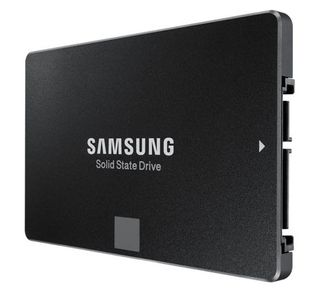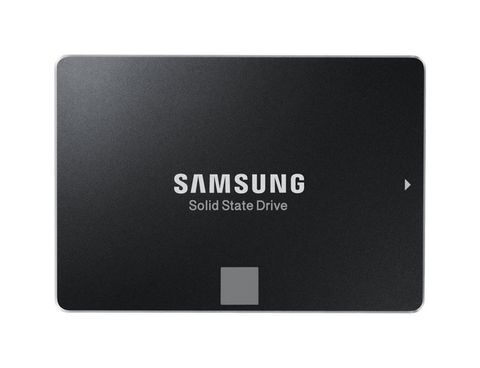Early Verdict
The 850 only has a three-year warranty, so it's downstream from the 850 EVO, but that doesn't mean it's a replacement for the 650 or 750 EVO. The 850's performance is very high for the 128GB-class, but that's standard issue for Samsung SSDs.
Pros
- +
Samsung SATA (high) performance
- +
Low cost
- +
Support for Magician and Rapid Mode
- +
Consistent performance
Cons
- -
Limited availability
- -
Single and low capacity (at the time of writing)
- -
Reduced warranty compared to 850 EVO
Why you can trust Tom's Hardware
Samsung's 64-Layer 3D V-NAND Comes To The Desktop
We found Samsung's unannounced new 850 SSD and couldn't resist the chance to take it for a spin. We've seen Samsung's new 64-layer 3D V-NAND in the T5 portable SSD, but the 850 marks its retail debut in a drive designed specifically for the desktop PC. Samsung claims its 64-layer TLC V-NAND is faster and more reliable than previous generations, so the company is overhauling its entire product stack as it brings its latest flash to market.

Samsung's new 64-layer V-NAND stores three bits per cell in a vertical structure, which is commonly referred to as 3D TLC NAND. Each 256Gbit die features roughly 85.3 billion cells. The new die has the same 256Gbit capacity as Samsung's previous-generation 48-layer NAND but features a smaller die, meaning it packs more data into a smaller footprint. That leads to reduced cost.
Samsung also made a few performance tweaks under the hood. The new die features a 1Gb/s data transfer rate, which is a 25% increase over its predecessor. The company also reduced the page program time, which is the amount of time it takes to program NAND cells, to 500 microseconds. Samsung claims that is 1.5X faster than its 48-layer V-NAND. The company also claims a 20% increase in reliability.
The new 120GB 850 is not a replacement for the 850 Pro or 850 EVO lines, though. Less than 24 hours after we found photos of Samsung's new 850 (non-EVO/non-Pro) SSD, Samsung released the drive in China.
The 850 could be the replacement for Samsung's 750 EVO, which is a product designed for the system integrator and OEM markets. The 750 EVO offers similar performance to the new 850, but it uses older planar (2D) NAND. It's still widely available but often costs as much, if not more, than the popular 850 EVO. Like the 850, Samsung's 750 EVO also debuted as a 120GB model in China. Samsung later added 250GB and 500GB 750 EVO's and released them worldwide. The 850 might see higher capacities if Samsung extends it to the global market.
The Samsung 850 could also replace the true entry-level 650 SSD that most of us have never heard of. The Samsung 650 with 32-layer V-NAND (3D) has been out of stock at Newegg for several months. Samsung's Australian site also lists it as "end of life" status.
The company has already released several new versions of its OEM models, such as the PM871b, with 64-layer V-NAND. These drives often sell in basic systems from Dell, Lenovo, and other OEM brands. Customers often do not select the components in those systems, so the OEM models fly under the radar.
Samsung isn't saying much for now, but it should answer our questions in early 2018. That's when we expect it to roll out new retail SSDs.
Specifications
Samsung's website only lists the 120GB model, and our reseller only had access to this capacity. According to the specifications on Samsung's Chinese site, the new 850 uses the MGX controller from the 850 EVO series, though we suspect there may have been firmware enhancements. The 850 and the 850 EVO have the same 540/520 MB/s sequential read/write specifications. The 850 has slightly lower random read performance of 70,000 IOPS compared to the EVO's 94,000 IOPS. Both models boast the same "up to" 88,000 random write IOPS rating.
We abandoned testing 128GB-class SSDs two years ago. We expected 512GB to be the lowest capacity with SSDs featuring new high-density 64-layer 3D NAND, but the flash shortage stifled progress and led to inflated pricing. That wasn't the only reason we abandoned this capacity class, though. Performance has also been very low in the products we've tested. Meanwhile, the size of applications has also grown. A significant number of modern PC games consume up to 100GB, so we had to draw the line at a reasonable amount of usable storage capacity.
Features

When we examine downstream models, it's often better to start with the features that are not available, rather than those that are. According to the website, the 850 does not feature TCG Opal or Microsoft's eDrive encryption. The drive has a PSID, which is the twenty-digit code you'll need to perform a cryptographic erase. The cryptographic erase feature was available on the 750 EVO, 850 EVO, and Pro, but it was not available with the older 650 series.
The marketing material does list 3bit MLC (TLC) V-NAND, but it doesn't specifically list it as 64-layer. Our sources have confirmed the 850 uses 64-layer V-NAND. The drive also supports Samsung's Magician management software and the Rapid Mode RAM caching feature.
Pricing, Warranty, And Endurance
The Samsung 850 currently only comes in 120GB with the MZ-7LN120 model number. Samsung has only released the drive in Asia, so we don't have any pricing information.
The drive comes with a three-year warranty, but the endurance for this model could be either 75 TBW (Terabytes Written) or 100 TBW. We found 75 TBW in the specifications and 100TB in the product text. Companies often copy product pages from previous releases and simply replace the data for the new model. That could be why the pages list different endurance ratings.
This the first drive in the 850 series to ship with a three-year warranty instead of a five- or ten-year warranty.
Accessories And Software
Samsung stopped selling "kit" drives, which come with an accessory package, a few product generations ago. The new products ship as a bare drive with a bit of paperwork. Samsung provides access to the Magician management software for every channel SSD. Samsung's product page also says the 850 supports Rapid Mode via the Magician software. Rapid Mode uses your PCs system memory (RAM) to cache storage traffic. This increases performance for cached data requests and reduces wear on the NAND.
Packaging



Samsung doesn't list many product details on the retail package. The company doesn’t even list the drive model on the front of the box. On the back, we found the “V-NAND SSD 850” and “3-year limited warranty” standing out from the rest of the text. Performance and endurance information are both missing.
Inside we found our 850 SSD in a form fitting plastic shell along with a generic Samsung Solid State Drive manual.
A Closer Look




On the surface, the 850 looks exactly like the 850 EVO. We also see the PSID number on the rear of the drive.
Internals





Samsung managed to fit all three major components on one side of the PCB. Samsung's website lists the controller as the MGX, the same as the 850 EVO. The drive does not use PoP (Package on Package) technology like the 750 EVO. That technology fuses the controller and DRAM together in the same package, but it adds some extra cost to the design.
MORE: Best SSDs
MORE: How We Test HDDs And SSDs
MORE: All SSD Content
Current page: Samsung's 64-Layer 3D V-NAND Comes To The Desktop
Next Page 128GB Class Performance Testing-
DerekA_C ha shortage my BUTT it's a cash cow right now as everyone is trying to switch over so why not make a few extra billion of gullible people just like everything else the fabs the money the time and investment is already there for years yet prices hiked bogusly, no one can convince me otherwise same with the GAS shortage all a bunch of BS to make extra billions to screw the population over PERIOD. Oh just like the LCD TV panel shortage HA then 4 companies including Samsung sued for 1 billion for strong holding the market. Practice as usual the elite finding new ways to make themselves more rich and powerful.Reply -
USAFRet So how is this new and different from the current 850 EVO drives?Reply
This, from my existing 850 EVO:
Yes, mine is a 500GB vs the test subject of 128GB, but just because there is a different TLA at the end of the model number does not make it 'better'. -
zodiacfml Not bad. I could use one but I bought 250GB EVO just a few days ago to match a 4TB HDDReply -
bit_user Please try to report the power-off data retention time of SSDs you review. As bits are being packed more densely, I suspect this number is falling and might already be low enough to cause issues for some people. For one MLC SSD I own, it's just 3 months.Reply -
Jeffs0418 Reply
How does one determine Power-off data retention time without TIME? That would fall under the Long-Term test.20426654 said:Please try to report the power-off data retention time of SSDs you review. As bits are being packed more densely, I suspect this number is falling and might already be low enough to cause issues for some people. For one MLC SSD I own, it's just 3 months.
-
mapesdhs Would be interesting to see how this compares to the old 840 and 840 Pro, and indeed the 830, see whether the competition has at least caught up to those older models (excluding the 840 EVO, too many issues with performance degradation over time).Reply
-
fanafirmino Must I endure a video of someone playing games everytime I hit your homepage??? Come on, there must be another way, guys!Reply -
bit_user Reply
It should be specified by the manufacturer, as in the case of my Intel drive. If it's not in the datasheet, then I would like the author to contact the manufacturer and ask them what it is. This will also hopefully send the message that people care about this attribute, and perhaps they'll be more mindful of it.20428005 said:
How does one determine Power-off data retention time without TIME? That would fall under the Long-Term test.20426654 said:Please try to report the power-off data retention time of SSDs you review.

